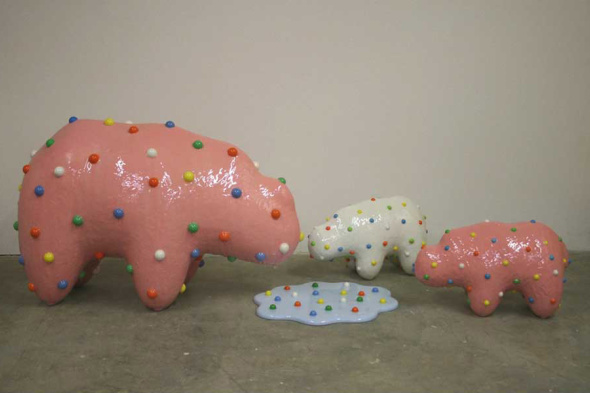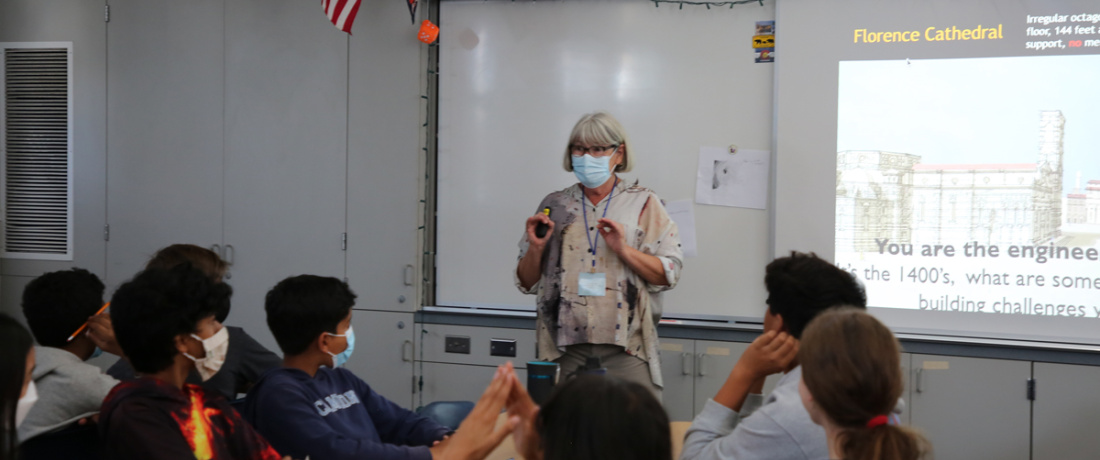Arts

- Exhibition Spotlight: Tending and Dreaming: Stories from the Collection
- Digital Visual Communication
- Discovering Art Through Critical Thinking
- Mexican Art and Activism
- Resident Alien: Hung Liu
Image: Thesis/Antithesis, 1998, Enrique Chagoya.
Languages

- Diego Rivera and Frida Kahlo
- Mexican Art and Activism
- Discovering Art Through Critical Thinking
Image: The Two Fridas, 1939, Frida Kahlo.
History

- Ancient Civilizations
- Middle Ages and the Renaissance
- American Art 1700–1900
- Civil Rights in America
- Mexican Art and Activism
Image: Trade goods Constantinople.
Science and Math

- STEAM = STEM + Art
- Digital Visual Communication
Image: Melt, 2008, Walter Robinson.
Arts
Exhibition Spotlight: Tending and Dreaming: Stories from the Collection
Grade 6-8, Arts – All levels, Language – All levels
Students use critical thinking skills as they perform an in-depth analysis and interpretation of artworks in the San José Museum of Art’s first dedicated collection galleries of pieces from the permanent collection. Highlighting artists as storytellers, students will uncover the many diverse voices and themes woven throughout the featured works including paintings, sculpture, and photography.
Digital Visual Communication
Grades 6–8, Multimedia, Project-based learning subjects - All levels
Students explore graphic design, infographic and presentation design, typography, and data visualization in the context of effective visual communication. They discuss and analyze how the selection of the content, the selection of the media, the elements of art, and the principles of design affect modern communication.
For a more in-depth program, a two-part presentation option is available. The topics covered in each part will be selected based on your curriculum.
Discovering Art Through Critical Thinking
Grades 6–8, 2-D Art - All levels
Students use critical thinking skills to perform an in-depth analysis of form and content while looking at a small number of contemporary artworks. They compare and contrast themes and the use of the elements of art, style, and varying media. Students interpret an artwork’s meaning and identify cultural and global significance while assessing how point of view and purpose shapes the content and style of the work(s).
Mexican Art and Activism: The Legacy
Grade 6–8, 2-D Art - All levels
Explore the artistic legacy of post-revolutionary Mexico and learn how it inspired artists across the border and around the world, including WPA muralists, Chicano artists, and contemporary street artists.
Resident Alien: Hung Liu
Grades 6–8, 2-D Art - All levels
Students use critical thinking skills as they perform an in-depth analysis of form and content in Hung Liu’s art, focusing on self, society, politics, and challenges of reconciling differing cultures. Drawn to photographs, Liu paints from her own, those of historical Chinese, and Dorothea Lange’s images. She blends her individual story with larger themes of history, as she rescues the dignity of the dispossessed both in China and the United States. Chinese symbolism inspires interpretation as students analyze the meaning of her artworks.
Request an Art in the Dark Presentation
Languages
Diego Rivera and Frida Kahlo: Defining Mexican Identity
Grades 6–8, Spanish - All levels
Students view Rivera’s murals and paintings and Kahlo’s self-portraits and other paintings, learning how their lives intertwined and how their styles differ. The connection among modern Mexico, the United States, and Russia is also discussed through the artworks of the two artists. Students look for the influences of cultural ideals and inventions on art.
Mexican Art and Activism: The Legacy
Grades 6–8, Spanish - All levels
Explore the artistic legacy of post-revolutionary Mexico and learn how it inspired artists across the border and around the world, including WPA muralists, Chicano artists, and contemporary street artists.
Discovering Art Through Critical Thinking
Grades 6–8, English, ESL - All levels
Students use critical thinking skills to perform an in-depth analysis of form and content while looking at a small number of contemporary artworks. They compare and contrast themes as well as the use of the elements of art, style, and varying media. Students interpret an artwork’s meaning and identify cultural and global significance while assessing how point of view and purpose shapes the content and style of the work(s).
Request an Art in the Dark Presentation
History
Ancient Civilizations
Grade 6
Students observe and discuss the art and architecture of the early civilizations of Mesopotamia, Egypt, Ancient Israel, India, China, Greece, and Rome. Students look for cultural similarities and differences between the diverse peoples studied.
Please note that content will vary depending on the presentation time so please let your docent know your preferences.
Two or three-part presentation options are available. The topics covered in each part will be selected based on your curriculum from the following list:
- Prehistoric Art and the Art of the early civilizations of Mesopotamia, Egypt.
- Art of Ancient Israel, India, and China.
- Art of Ancient Greece, and the Roman Empire.
Middle Ages and the Renaissance
Grade 7
Students analyze and discuss the interconnection of middle ages art of Rome and Christendom, the Islamic World, West Africa, South Asia, East Asia, and the Americas. They will look at the impact of trade, religion, geography, and inventions on art and architecture. In the Renaissance presentation, students observe and discuss the evolution of art in Italy and Northern Europe with examples from Giotto, Brunelleschi, Donatello, da Vinci, Michelangelo, van Eyck, and Dürer.
Please note that content will vary depending on the presentation time, so please let your docent know your preferences.
Two or three-part presentation options are available. The topics covered in each part will be selected based on your curriculum from the following list:
- Middle Ages: Art and Architecture of the Middle Ages in Rome and Christendom, the Islamic World, West Africa, South Asia (India), East Asia (China, Japan, and Korea), and the Americas.
- Renaissance: Art of the Italian and Northern European Renaissance.
American Art 1700–1900
Grade 8
Spark new interest in American History! Students explore the art of the late Colonial Period, the American Revolution, the Early Republic, and of the Northeast, the South, the Westward Movement, the Civil War, and the Industrial Revolution. Engaging class drawing activities afford students a deeper examination of art works and understanding of the origins of American Identity.
Civil Rights in America: American Artists and the Struggle for Equality
Grade 8
Students explore social justice and American Ideals as they interpret art by American artists from the pre-civil rights era to the present. Topics include the Civil Rights Movement during the 1950s and 1960s, the Chicano Movement of the 1960s, the Civil Rights of Japanese Americans and how contemporary artists represent these issues today.
Please note that content will vary depending on the presentation time, so please let your docent know your preferences.
Mexican Art and Activism: The Legacy
Grade 8
Explore the artistic legacy of post-revolutionary Mexico and learn how it inspired artists across the border and around the world, including WPA muralists, Chicano artists, and contemporary street artists.
Request an Art in the Dark Presentation
Science and Math
STEAM = STEM + Art
Grade 6–8, By grade
Students examine artworks and artistic processes that provide real-world examples of the integration of art with math, science, technology, and engineering. Using the Math CCCSS and the NGSS as guides, these presentations are tailored for each grade level and can be requested by subject focus. The following lists our standard content by grade:
- Grade 6 Science: California landscape’s connection with earth science geology; EcoArt’s connection with earth and human activity, global warming; Bio Art’s connection with organism structure cells; and Land Art’s connection with earth systems water cycle.
- Grade 6 Math: Egyptian, Greek, and Renaissance Art’s connection with ratios, unit rate, and algebraic expressions; ancient to modern art’s connection with the golden ratio; modern geometric art’s connection with basic geometry.
- Grade 7 Science: Renaissance Art’s connection with chemical reactions and the scientific process; EcoArt’s connection with biodiversity and ecosystems; Bio Art’s connection with cells; Land Art’s connection with earth systems erosion, Naturalist Art’s connection with photosynthesis and evolution.
- Grade 7 Math: Renaissance Art’s connection with constant of proportion, engineering design, linear equations, linear perspective; OP Art’s connection with informal geometric structure, New Media Art’s connection with linear equations.
- Grade 8 Science: Light Art’s connection with waves and basic electronics; Kinetic Art’s connection with Newton’s Laws, Law of Levers, and energy; Astrophotography’s connection with the solar system; and Land Art’s connection with engineering design; Rube Goldberg machine’s connection with simple machines, engineering design, and energy.
- Grade 8 Math: Light Art and Animation’s connection with functions and bivariant data; Tessellation Art’s connection with geometry and proportions.
Digital Visual Communication
Grades 6–8, Multimedia, Project-based learning subjects, Yearbook - All levels
Students explore graphic design, infographic and presentation design, typography, and data visualization in the context of effective visual communication. They discuss and analyze how the selection of the content, the selection of the media, the elements of art, and the principles of design affect modern communication.
For a more in-depth program, a two-part presentation option is available. The topics covered in each part will be selected based on your curriculum.
Request an Art in the Dark Presentation
Special Day Classes
Art for You
Grades 6–8, SDC
Students participate in a fun, informative, and interactive look at the way we communicate through art using the elements of art. The presentation adapts to fit wide-ranging needs and capabilities of the special education student. Your docent will work with you to provide the drawing activity, video, and artwork selections, and mode of delivery that will best meet the needs of your students.
For a more in-depth program, a two-part presentation option is available. The topics covered in each part will be selected based on your curriculum.

